Website: www.sednet.org
Compiled by: Marjan Euser (marjan.euser@deltares.nl)
Subscription Service: SedNet Secretariat (marjan.euser@deltares.nl)
Disclaimer: SedNet is not responsible for faults due to incorrectness of info in this newsletter.
Previous issues: www.sednet.org/newsletter
CONTENTS
8th International SedNet conference
Lisbon, Portugal, 6-9 November 2013
Date and venue have been set for the next SedNet conference, so please mark your diary!
The conference program will include the following topics:
Sediment and ecosystems, quantity and quality issues, estuarine and coastal dynamics, sustainable dredged material management.
A Call for Abstracts is under construction and will be disseminated later this year.
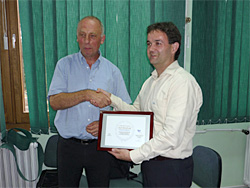
Axel Netzband (left) and Marc Eisma
Since 2005 Axel Netzband of the Hamburg Port Authority has been chairman of SedNet.
Early 2012 Axel decided to withdraw as chairman in order to give room to a new candidate. At the Steering Group meeting in September 2012 Marc Eisma of the Port of Rotterdam Authority was elected as Axel’s successor. Also a vice-chair was elected: Christophe Mouvet of BRGM, France.
At the Steering Group meeting Axel was thanked for the excellent work he has done all these years for SedNet. Axel received a “Best SedNet Chairman Award” from the Steering Group.
Axel will stay on as regular Steering Group member.
The Steering Group congratulated Marc Eisma and Christophe Mouvet in their new role and wished them success with the management of our network.
Sediment management course highly valued in the Sava river basin
The “practical training course on sustainable sediment management with the Sava river basin as showcase” was held 15-18 October 2012 in Zagreb, Croatia. It was organized in close cooperation by the International Sava River Basin Commission (ISRBC), UNESCO Venice Office, UNESCO IHP International Sediment Initiative (ISI) and SedNet. The participants valuated the course in general as ‘very good’. They gave the same rate for the aspect ‘usefulness’.

The course (photo: Samo Grošelj)
A nice summary remark of one of the participants: “It really is and will be a “showcase” for other international planning. The planning will certainly make the case for the importance of understanding the dynamics and functions of sediments.”
This was the first part of the course. This part focused on how to achieve a sediment balance and on monitoring and assessment of the quantity and quality of sediments in the Sava.
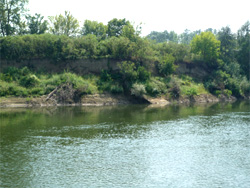
Eroding Sava riverbanks: one of the sediment management issues (photo: Jos Brils
Top experts from Europe and the United States of America addressed the theory on these topics. The national experts from the four Sava countries – Slovenia, Croatia, Bosnia & Herzegovina and Serbia – subsequently presented the status of their own countries for these topics. Thereafter, the course participants were assisted by a professional moderator in connecting ‘theory’ to ‘practice’. The course participants were twenty local experts (policy makers, agencies and scientists) from the Sava river basin. It is the intention that they will get involved in the drafting of the sustainable sediment management plan for the Sava river basin. The four Sava countries committed themselves to get to such a plan.
| The main outcomes of the course: | |
| ● | The participants – for several of them it was the first time they met – now share a common understanding on the key sediment management issues for the Sava; |
| ● | These issues are: too much, too little or too dirty sediment, now or in the future. This is, or can be, caused by further improvement of the navigability of the Sava, soil erosion, pollution (agriculture and industrial) and existing and planned dams; |
| ● | Based on a thorough brainstorming during the practical part of the course, the participants are expected to achieve the final course objectives by drafting the guidance and the implementation programme for the development of the Sava sediment management plan, as well as identifying the projects needed to develop different modules of the Sava sediment management plan; |
| ● | The secretariat of the ISRBC will propose to the Commissioners to endorse the formation of an ISRBC expert group to deal with sediment management. That group will then guide the further drafting of the sediment management plan. |
We are now even more motivated to prepare part 2 of the course, in which we will address measures and governance aspects. Once we succeeded in securing the funds for part 2 of the course, and also successful conclusion of that part, it is the intention of UNESCO to promote and offer the course globally and thus to contribute to a more sustainable management of sediment in any river basin that is willing to face this challenge.
Part 1 of the course was made possible by the in kind cooperation and/or sponsorship of several institutions that we greatly want to acknowledge: UNESCO Venice Office, UNESCO Germany IHP National committee, UNESCO IHP ISI, ISRBC, BRGM, HAW, VMM, Deltares and SedNet. All presentations given during the course are available at the ISRBC website (http://www.savacommission.org/event_detail/8/22/273) as well as at the SedNet and ISI websites.
For more information you may contact the course leader:
Jos Brils (jos.brils@deltares.nl).
SedNet short course at COASTEXPO 2012
On September 20, 2012 SedNet organised, following the invitation of the Scientific Committee, a Short Course on Sediment Management at COASTEXPO 2012. COASTEXPO is a Conference and Exhibition held annually in Ferrara (Italy), focused on Coastal Zone Management issues. Title of the course was: “Lessons learned from success Case Studies of sediment management in Europe”. The course was organised and coordinated by Andrea Barbanti, member of SedNet SG, while the 2 case studies were presented by Bruno Lemiere – BRGM (Inland waterways sediment management in Northern France and Walloon Belgium) and Jos Brils – Deltares / SedNet SG (Sustainable sediment management in the Scheldt-Meuse-Rhine delta).
Aim of the course was to give the opportunity to sediment-related problem owners (or expected problem solvers) to get in contact with significant and state-of-the-art experiences on sediment management and share best practices. The interactive (and informal) format of the course offered the opportunity to the participants: i) to explore in details the ingredients of a success Case Study (not only a matter of technicalities); ii) to reflect in the Case Studies their own experiences and open issues; iii) to interact and share experiences with other participants.
| Topics addressed have been: | |
| ● | Technical and scientific aspects (site assessment, parameters and quality standards, decision frameworks, systemic approach, conditions for reuse/disposal, treatment types, tools, monitoring, sustainability analysis,…) |
| ● | Legislation and protocols: principles and main practical consequences / practices |
| ● | Administrative: institutional framework, decision making, procedures, permits |
| ● | Economics: costs of measures, financing, incentives, private-public initiatives. |
About 30 people – mostly from Italy – with different backgrounds and interests (Central/Local Administrations, Port Authorities, Environmental Agencies, Universities and Research, Operators and Consultants) attended the course. The course was highly appreciated by the attendants and they participated lively in the discussions.
Presentations are available at the Conference website.
SedNet Symposium “Understanding sediment processes at catchment scale”, Koblenz, Germany, June 2013
SedNet is organising a one day symposium at the 6th IAHS International Conference on Water Resources and Environmental Research: Water and Environmental Dynamics , which will run from 3-7 June 2013 in Koblenz, Germany. The SedNet symposium is on Understanding sediment processes at catchment scale and is convened by Peter Heininger (Federal Institute of Hydrology, Germany), Sue White (Cranfield, UK) and Ivana Teodorovich (University of Novi Sad, Serbia).
Session abstract: Sediment as an essential condition for the hydrological, geomorphological and ecological functioning of river basins, as a pollutant in its own right, and as a vector for other associated contaminants, crosses many traditional management sectors, and is subject to many sets of legislation or regulation. There are often multiple sources of sediment affecting multiple management objectives in locations throughout river basins, and the transfer pathways between source and impact are often long and complex. Mobilisation and movement of sediment is often associated with high energy, high flow events, and few monitoring programmes adequately address this part of the flow range. Climate change predictions are for such events to become both larger and more frequent, and the resultant shift in flow distributions will mean that rivers will remobilise, releasing both sediment and legacy contaminants from floodplains and river banks and bed. Changing physical and chemical conditions may also mean that sediment-bound contaminants will behave differently in future.
Meanwhile, the European Water Framework Directive (WFD) requires us to manage our water environment at catchment scale. This is perhaps more complex for sediment than for other contaminants because of the episodic nature of sediment transfer, long storage times within the system and the wide range of associated contaminants. However, for many river basins in Europe sediment and/or associated contaminants form one of the major barriers to meeting WFD requirements. Therefore there is an urgent need to develop approaches based on process understanding for sediment management at catchment scale.
This session will welcome papers on catchment scale management approaches, improved process understanding and implications of a changing environment on sediment management at the river basin scale.
December 16th is the deadline for abstracts – so please start planning your paper now! Further details about the conference can be found at:
www.water-environment.org.
Estuarine Coastal Sciences Association hosted special session at SedNet 2013 Portugal “Changing Hydrodynamics of Estuaries and Tidal River Systems”
The Estuarine and Coastal Sciences Association, ECSA, will be hosting a special session at next year’s SedNet conference in Portugal. The session will be presented by 3 keynote speakers from ECSA with expertise in estuarine hydrodynamics, contaminant processes and ecology. They will outline current knowledge and tools for understanding and predicting changing hydrodynamics in estuarine systems and explore the implications this may have for the fate of contaminants and nutrients and the ecological status of estuaries. The presentations will be followed by a discussion of the gaps in scientific and technical knowledge and the short- to medium-term consequences for management.
The presentations will focus on the interactions between tidal and fluvial hydrodynamics in estuarine and tidal freshwater rivers and their influence on chemical and biological processes over various timescales. The speakers will explore the responses to, and consequences of, human interventions, such as tidal barrages, weirs, restoration and flood management/storage schemes, and to predicted changes in the frequency and magnitude of coastal storm surges, river discharge and sea level rise. Natural and human-induced changes to estuarine hydrodynamics and geomorphology will affect the transport of sediment (mud, silt and sand), including the redistribution of contaminated bed sediment. Similarly, the transport of suspended sediment from catchment to coast is fundamental to the ability of estuaries to ‘filter’ contaminants, consequently any modification of physicochemical gradients occurring across the saltwater:freshwater interface will influence the fate of contaminants. All these factors may have wide ranging implications for water and sediment quality, biogeochemical cycling (e.g nutrients and contaminants), and ultimately the ecological status of estuaries and their tidal reaches.
The Estuarine and Coastal Sciences Association is an international organization dedicated to the promotion and advancement of multidisciplinary research into all aspects of estuaries and coasts, and the application of science and technology for their sustainable environmental management. ECSA’s activities, interests and membership extend throughout Europe and to many other regions around the world. The Association has been involved in the organization of nearly 50 conferences to date, with future events planned for China, SE Asia and Brazil. The Association also supports local meetings concerning regional estuaries or coastal areas, and arranges scientific workshops. ECSA has an associated international journal Estuarine and Coastal Shelf Science and also supports the production of a variety of other scientific publications including a Bulletin for members, with two issues each year.
 Please visit ECSA’s website for details of publications, forthcoming events and membership.
Please visit ECSA’s website for details of publications, forthcoming events and membership.
9th Flemish Water forum: ‘Sediment, the hidden link in water policy’
The Coordination Commission Integrated Water Management in Flanders organized their 9th water forum on June 1st, 2012. The central theme of this forum was sediment as the hidden link in water policy, to emphasize the added value of a joined and integrated sediment management. The forum was opened by Jos Brils who presented the vision of SedNet regarding the need to change sediment management from a waste oriented perspective into an integrated management approach on a basin scale tackling the challenges we are facing today and tomorrow with regard to integrated water management. Subsequently six themes were addressed namely: ‘reduction of sediment inflow’, ‘ room for sediment’, ‘ creative and efficient dredging’, ‘monitoring and modeling’, ‘solving the problem of contaminated sediments’ and ‘treatment and reuse of sediments’. The scope of each theme as part of the hidden link within integrated water policy and management was presented followed by some examples from the field.
170 people, representing policy makers, water managers, research institutes, universities, consultancies and ngo’s attended the forum. There was a general consensus that the development of a good sediment balance, an improved understanding of the link between sediment, water quality and ecosystem services, and good communication with regard to these issues is essential to get support for taking measures to enhance sustainable sediment management and to improve the status of our water bodies. All stakeholders confirmed to focus also on sustainable sediment management when making up the second generation of river basin management plans. Finally everyone showed also engagement to work on a positive perspective for sediment related issues in Flanders.
The presentations (in Dutch) and an animation movie can be found on
www.integraalwaterbeleid.be.
Blueprint to safeguard EU-waters has been approved
TheCommission has launched a Blueprint to Safeguard Europe’s Water Resources, a strategy for ensuring that enough good quality water is available to meet the needs of people, the economy and the environment.
EU waters are not doing well in terms of quality, despite improvements in recent years. Water quantity is of equal concern with water scarcity spreading in Europe and extreme events (like floods) increasing in too many Member States.
We must step up our efforts in order to deal with old and emerging challenges, including water pollution, water abstraction for agriculture and energy production, land use and the impacts of climate change. Strengthened measures are needed to help the EU protect its water resources and become more resource (including water) efficient.
Environment Commissioner Janez Potočnik said: “This Blueprint shows we have a good understanding of the problems we face and a solid platform to tackle them. The time has come to take action to deliver the full benefits of our legislation and create opportunities for innovative solutions in water policy and the water industry. What is needed is a sustainable balance between water demand and supply, taking into account the needs of both people and the natural ecosystems they depend on.”
The Blueprint can be downloaded here. Pressrelease you can find here.
Commission Presents New Guidelines for Inland Navigation and Natura 2000, with relation to maintenance dredging
Session On 18 October the European Commission published new guidelineson inland navigation and nature protection to assist the sector in applying EU environmental legislation.
The guidelines emphasize the development of inland waterway transport infrastructure as well as the conservation of rivers from the perspective of protecting Europe’s rare species and habitats under the EU Birds and Habitats Directives and in the wider context of the Water Framework Directive.
The Commission guidelines provide guidance on how best to ensure that activities related to the development and management of inland waterways are compatible with EU environmental policy in general and nature legislation in particular. The document focuses on the construction, maintenance and upgrading of infrastructure projects related to commercial inland waterway transport. It was written in consultation with members of the European Commission Working Group on Rivers which has provided valuable feedback on the various drafts of the guidance document.
Particular attention is given to explaining how to develop integrated projects which aim to take account of the river’s ecological processes early on in the design process and which search for win-win solutions for both inland waterway transport and biodiversity wherever possible. This guidance document also outlines the procedures to follow when carrying out an appropriate assessment under Article 6 of the Habitats Directive. In that respect, specific reference is made to capital and maintenance dredging works. In the guidelines, the Commission confirms that maintenance dredging works normally only maintain a certain state of infrastructure and do not qualify as a project in the sense of Article 6(3) of the Habitats Directive. Maintenance operations may only be regarded as constituting distinct projects in cases of changing techniques, conditions or regularity under which they are carried out.
The document complements previously published “guidelines on developments in ports and estuaries”, which were published in 2011.
Portuguese Marine Strategy addresses sediment contamination
The Marine Strategy Framework Directive (MSFD), adopted in 2008, establishes a framework within Member States shall take the necessary measures to achieve or maintain good environmental status in the marine environment. The first major reports by Member States to the Commission are due in 2012, covering an initial assessment of marine waters, the determination of good environmental status and the setting of environmental targets. The draft version of the Portuguese report was made available for public consultation in September. The report concludes that overall the Portuguese marine waters are in good condition, but that there is still room for improvement. With regard to Descriptor 8, the concentrations of contaminants are at levels not giving rise to pollution effects in all but one area – the continental shelf close to the Tagus and Sado estuaries. In this area, under greater influence of important cities, ports and industries, the ‘good environmental status’ target was considered not reached due to sediment contamination by hazardous substances. However, the report recognizes that the situation mainly results from historic contamination. Metal concentrations in marine fish species have been observed to decrease in the same area over the last decade (Mar Pollut Bull 62:2854-2858), which is encouraging with regard to the long-term improvement of marine sediment quality.
ARCH: Architecture and roadmap to manage multiple pressures on lagoons
ARCH is a four-year collaborative research project funded by the Seventh Framework Programme for research and technological development (FP7) of the European Commission. Thematically the project belongs to Cooperation Theme 6 Environment (including climate change). The project team is composed of 11 institutions from 9 European countries and coordinated by the Norwegian Geotechnical Institute (NGI). Through experimentation with and development of innovative knowledge brokering instruments, ARCH aims to develop participative methodologies in collaboration with the involved managers, policy makers and stakeholders to manage the multiple problems affecting lagoons in Europe.
State-of-the-Lagoon reports
The task of the ARCH is elaboration of ‘integrated lagoon management plans’ for selected case studies. To understand the complexity of the lagoon regions “state-of-the-lagoon” reports have been prepared for the 10 case study sites. They enlarge our knowledge and provide basis for discussions with the stakeholders. The reports show the dynamic functioning of each lagoon region. They also highlight how the lagoon communities manage and cope with adverse negative effects so important nowadays, i.e. they analyse evolutionary resilience of the lagoon regions in a long run.
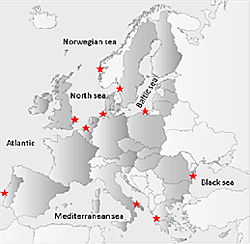 Stake holder involvementThe lagoon regions are described as a system composed of two interrelated parts: the “natural system” and the “human” system (composed of the socio-economic and the governance components). It has been decided to make use of both indicators and narratives for description of the main elements of the lagoon regions and respective interactions.
Stake holder involvementThe lagoon regions are described as a system composed of two interrelated parts: the “natural system” and the “human” system (composed of the socio-economic and the governance components). It has been decided to make use of both indicators and narratives for description of the main elements of the lagoon regions and respective interactions.
In complex environmental problems, responsibilities, knowledge and power are distributed among the actors involved. Thus stakeholders should be involved, because they are responsible for certain aspects of the environmental problem, they have specific knowledge that should be brought into the process, or because they have a certain power: power to obstruct or power to realize. Stakeholder involvement as a process differs from traditional public consultation procedures in that stakeholders are involved early enough to influence policies when they are formulated. It makes sense, thus, to involve stakeholders in policy problems that are complex, and we should do that from an early stage of the policy process. The next stage of the project will therefore focus on stakeholder involvement through a series of 3 workshops at each case study site.
For more information: www.arch-fp7.eu.
New Research Projects in the UK
The The UK national Research Councils are funding a number of research studies which include the role of sediment and debris in flooding. Two projects have already been funded by the Engineering and Physical Sciences Research Council and will start in January 2013 and run for 3 years:
| ● | Delivering and Evaluating Multiple Flood Risk Benefits in Blue-Green Cities: The aim is to develop new strategies for managing urban flood risk as part of wider, integrated urban planning intended to achieve environmental enhancement and urban renewal in which multiple benefits of creating blue-green cities are rigorously evaluated and understood. One of the objectives is to model existing flood risks using coupled surface/sub-surface hydrodynamic models linked to semi-quantitative assessments of sediment/debris dynamics and habitats, using fieldwork where necessary to fill knowledge gaps in urban drainage network forms and functions |
| ● | Flood MEMORY: Multi-Event Modelling Of Risk & Recovery: The aim is to study the impacts of clusters of floods in terms of the memory of physical and social systems. The temporal clustering of flood events in time has a critical effect in reducing the ability of systems to recover to pre-flood conditions which can lead to amplified damage in a second flood event. This can be considered as system “memory”, the timeframes of which will be highly variable and range from days to years according to system component. Whilst major floods undoubtedly mobilise channels and large amounts of sediment, repeated small floods play a role in adjusting hillslopes and channels back to an “equilibrium” state. This means that the assumption of similarity in flood risk for similar events is unfounded. The project will consider both fluvial and coastal flooding through source-pathway-receptor models in the fluvial environment and models of beach change for coastal floods. |
Further information on sediment aspects of these projects can be obtained from Sue White, sue.white@cranfield.ac.uk
Meanwhile a major funding initiative from the Natural Environment Research Council is focussed on improving our ability to predict and manage impacts of Flooding from Intense Rainfall. A major component of this work will relate to the crossing of process thresholds in sediment and debris supply (hillslope erosion, gullying, landslides, rural and urban debris and changing channel morphology) alongside work on changing conveyance during floods due to the high sediment and debris inputs and blockage at key infrastructure (bridges, culverts, drains). Funding will start in April 2013 and successful bidders will be announced in late 2012.
Long-term suspended sediment data collection
A paper on long-term suspended sediment data collected from over 600 reference-condition (i.e. high ecological status) river sites (42 different ecosystem types) across the temperate climate zone, in order to (1) determine differences in the suspended sediment concentrations that are inhabited by different freshwater ecosystems, and (2) identify, through modelling, the catchment environmental characteristics that influence background concentrations of suspended sediment, was published this summer.
The paper can be found on www.sciencedirect.com
The corresponding author of the research group (Dr G. S. Bilotta, School of Environment and Technology, University of Brighton, UK) reports that they are currently working on the next phase of the model, improving the specificity of predictions and using alternative, more ecologically-meaningful, metrics of suspended sediment exposure (concentration-duration frequency approach).
Review on the International Magdeburger Seminar on River Protection, held on 10-11 October 2012, Hamburg, Germany
The 15th International Magdeburger Seminar on River Protection focused on “The River Elbe and its sediments”. For the first time in the more than 20 years long lasting history of the seminar it took place in Hamburg on the 10th and 11th October 2012. More than 180 experts from the German and Czech part of the Elbe river basin discussed the importance of sediments regarding their key ecological and hydrological requirements. A total of 24 papers and 50 posters with a spatial focus on the mountain and inland areas of the Elbe as well as the Tidal-Elbe and sediment management were presented. Relevant tributary streams of the Elbe such as Vltava, Mulde, Saale and Havel were also focused by the experts. In addition to the seminar three excursions were offered to get in touch with the qualitative and quantitative aspects regarding suspended sediment management of the river Elbe, especially concerning their relevance for the port of Hamburg.
Dr. Pavel Punčochář, president of the International Commission for the Protection of the Elbe River (ICPER) stated “To reach the goals of the European Water Framework Directive it is essential to consequently deal with the contamination issue of sediments”.
Further Dr. Heide Jekel from the Federal Ministry for the Environment, Nature Conservation and Nuclear Safety, Germany added “There is also an intensive discussion on sediment management in Germany within the River Basin Community Elbe (FGG Elbe), the national coordination platform for the German part of the River. Results of the group are used for the development of a national concept as well as an international ICPER-concept.”
Conference material, including presentations given, can be found atwww.ikse-mkol.org
The next International Magdeburger Seminar on River Protection was announced to be arranged in September 2014 at the source of the Elbe in Spindleruv Mlyn, Czech Republic.
More information about the Elbe:
Projekt Schadstoffsanierung Elbesedimente www.elsa-elbe.de
International Elbe Protection Commission www.ikse-mkol.org
German Elbe River Board www.fgg-elbe.de
Sustainable Management of Contaminated Sediments (SMOCS)
SMOCS – Unlocking port investments through emerging technologies
Demands for a sustainable transport system throughout the world give an ever increasing need to develop ports. Larger ships with deeper draught also add to the need to dredge. In the SMOCS project a guideline, tools and full scale tests have been performed in order to introduce a sustainability approach to managing contaminated sediments and to introduce new emerging technologies. One example of a technology being brought forward by the project is the stabilization/solidification technology that enables contaminated dredged masses to be used as material in port constructions, saving both money and environment thus enabling port investments.
Sustainable management of contaminated sediments, SMOCS
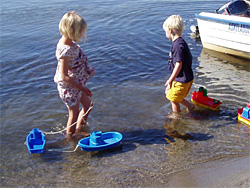
Sustainable dredging for our future…
SMOCS started late 2010 as a joint project comprising several countries around the Baltic Sea. The project is financed by the 10 partners and the Baltic Sea Region Program 2007-2013. A large number of associated and supporting organisations, such as environmental protection agencies, ministries, ports and port organisations provide support also enabling a strong and efficient dissemination of the project key results, findings and deliverables. In late 2012 SMOCS will be finalized and the guideline, tools for assessment and technologies will be released on the SMOCS website www.smocs.eu.
Dredged sediments are a resource as construction material
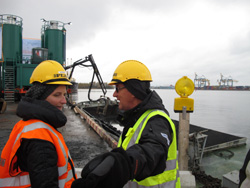
`Port of Gävle during stabilisation/ solifdification of contaminated sediments
The principle traditional faiths of dredged contaminated sediments are sea or land disposal. The first is not favourable due to environmental concerns in the Baltic Sea Region, the second is very resource demanding and costly. It is in this gap that stabilization and solidification technology has been brought forward and verified in the project, say Professor Sven Knutsson, Luleå University of Technology and Project Manager Göran Holm, Swedish Geotechnical institute. This technology has been used before but is now further developed and used in order to 1) treat the sediments through immobilization of contaminants, 2) improve the engineering properties and 3) enable the treated dredged sediments to be utilized as a construction material in port constructions. Performed sustainability assessments give a clear view on the technology; it decreases the need for natural ending material and has less impact on climate change than traditional handling methods; it is resource and cost effective.
Large investments due in Port of Kokkola, Port of Gävle and Port of Gdynia
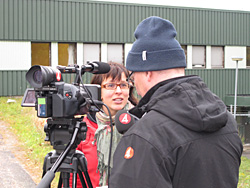
TV-broadcast concerning the field test in Port of Gävle
The cost for handling contaminated sediments is very high if done in a traditional manner with disposal them on a landfill says Linda Astner, Environmental Manager at Port of Gävle, Sweden. She continues, – As we were informed of the stabilisation/solidification technology we saw a possibility to save money, environment as well as enable the port to do complementary investments in its facilities. The Port of Gävle has started works in the autumn of 2012 that will treat and use about 600 000 m3 of contaminated sediments for new port areas for e.g. container handling. Soon Port of Kokkola , Finland and Port of Gdynia, Poland as well as others will follow.
SMOCS Network and PortInfra
An additional key output of SMOCS is a network, its heart consists of the ten SMOCS partners who joined the project in 2009, and who now have agreed to interact on the topics of sediments, port construction and to invite other organisations to participate starting 2013. One of the first tasks is to enlarge the network under the thematic umbrella “PortInfra” where the practical needs of ports are matched with best available knowledge.
For questions on sediment management and port construction issues as well as taking actively part in the SMOCS network, you can contact
Göran Holm, goran.holm@swedgeo.se or Bo Svedberg bo.svedberg@ltu.se
Or visit www.smocs.eu.
Photos in this article by Bo Svedberg LTU/Ecoloop and Göran Holm SGI
From the UNESCO-ISI Newsletter
Recently published
“River Discharge to the Coastal Ocean: A Global Synthesis”
by John D. Milliman, College of William and Mary, Virginia, USA
Katherine L. Farnsworth, Indiana University of Pennsylvania
Cambridge University Press 2011
Rivers provide the primary link between land and sea, annually discharging about 36 000 km3 of freshwater and more than 20 billion tonnes of solid and dissolved sediments to the global ocean. Utilizing the world’s largest database – 1534 rivers that drain more than 85% of the landmass discharging into the global ocean – this book presents a detailed analysis and synthesis of the processes affecting the fluvial discharge of water, sediment, and dissolved solids to the coastal ocean. The ways in which climatic variation, episodic events, and anthropogenic activities – past, present, and future – affect the quantity and quality of river discharge are discussed in the final two chapters. The book contains 26 tables and more than 165 figures – most in full color – including global and regional maps. The book’s extensive appendix presents the 1534-river database as a series of 44 tables that provide quantitative data regarding the discharge of water, sediment and dissolved solids. The appendix’s 140 maps portray the morphologic, geologic, and climatic character of the watersheds. A complete GIS-based online database.
| Other publications that can be found in the ISI Information System | |
| ● | Sediment Issues & Sediment Management in Large River Basins Interim Case Study Synthesis Report (ISI) |
| ● | Distribution, sources and ecological risk assessment of heavy metals in surface sediments from Lake Taihu, China (Yin et al.) |
| ● | Sediment dynamics of an impounded river: Yegua Creek, Texas (Martinez) |
| ● | Suspended sediment transport in the Ganges-Brahmaputra River System, Bangladesh (Rice) |
| ● | Nutrient and Suspended-Sediment Trends in the Missouri River Basin, 1993–2003 (USGS) |
| ● | rends in Streamflow and Nutrient and Suspended-Sediment Concentrations and Loads in the Upper Mississippi, Ohio, Red…(USGS) |
| More …(see www.irtces.org) | |
SEDI.PORT.SIL final meeting on 10-11 December 2012, Ravenna, Italy
The European Commission and the Port Authority of Ravenna co-finance MED Ingegneria and associated beneficiaries (University of Ferrara – Earth Sciences department, University of Bologna – Diem department, ISPRA, Po Delta Park, GeoEcoMar, DIEMME and CRSA MED Ingegneria srl) to develop an innovative process of treatment and reuse of harbour sediments.
The main aim is the restoration and valorization of sediments after dredging, and the production – after treatment – of sediments useful for infrastructural works, environmental engineering, etc. and the evaluation of silicon extraction.
The final meeting of SEDI.PORT.SIL. project (Recovery of dredged SEDIments of the PORT of Ravenna and SILicon extraction) will be held in Ravenna, at the premises of the Port Authority on 10th and 11th December 2012.
During the conference achieved results will be presented.
Visits to the Emilia-Romagna coastal zones and inside the harbour area are foreseen.
For more info and registration: www.lifesediportsil.eu, or contactcristinaveratelli@parcodeltapo.it / manager@lifesediportsil.eu /elisa.ulazzi@medingegneria.it
SE-LIST (the Soil Erosion Discussion List) has been re-launched this spring. It was started in 1993 as a forum for discussion on any topic related to soil erosion (Bernsdorf and Favis-Mortlock, 1995). The list was originally hosted by the University of Trier, Germany. It then went through several changes before Mark Nearing (USDA-ARS) agreed to run it. During Mark’s term of office, the list was hosted at Purdue University in the USA. It grew to be quite a useful resource.
In 2011, Mark decided to give up running the list, and pass it to someone else; David Favis-Mortlock, senior visiting research associate at the Environmental Change Institute | University of Oxford, agreed to take it on. It has taken a while, but the list is now operational once again. However, it has not been possible to copy the list of subscribers from the Purdue hosting. Thus members of the old SE-LIST will usually need to re-subscribe.
SE-LIST is intended to be a low-volume list, just a few emails per week.
The formal name of SE-LIST is now ouce-soil-erosion@maillist.ox.ac.uk
To post to the list, send an email to ouce-soil-erosion@maillist.ox.ac.uk. Your email will then be sent to all list members. You can only do this if you are subscribed to the list, of course.
To unsubscribe or subscribe, or check who is subscribed, send an email toouce-soil-erosion-help@maillist.ox.ac.uk. You will get an email back with a list of instructions.
If you have any problems posting to the list, you can send an email to ouce-soil-erosion-owner@maillist.ox.ac.uk. Feel free to pass on this announcement to any colleagues who might wish to join SE-LIST.
2012:
29 November 2012: Advanced course on Modelling Water, Floods and Sediments with Tetis v8.2, Valencia, Spain (Tetis v.8.2.4 can be downloaded here). See also website SCARCE project: www.idaea.csic.es
10-11 December 2012: SEDI.PORT.SIL – Recovery of dredged SEDIments of the PORT of Ravenna and SILicon extraction – final meeting, Ravenna, Italy. www.lifesediportsil.eu
2013:
4-7 February 2013: Battelle conference – Seventh International Conference on Remediation of Contaminated Sediments at the Hyatt Regency, Dallas, Texas
More info at: http://www.battelle.org/conferences/sediments/
26-28 March 2013: Intersol 2013 – International Conference / Exhibition on Soils, Sediments and Water, Lyon, France. www.intersol.fr
10-12 April 2013: GESeD – Environmental Management of Dredged Sediments in the framework of the SETARMS project, Caen France. More info: www.setarms.org
16-19 April 2013: AquaConSoil conference on management of soil, groundwater and sediments, Barcelona, Spain. www.aquaconsoil.org
3-7 June 2013: WODCON XX – World Dredging Congress, Brussels, Belgium
www.cedaconferences.org
3-7 June 2013: 6th International Conference on Water Resources and Environment Research (ICWRER), Koblenz, Germany. ICWRER 2013 is focused on Water and Sediment and is jointly organised with SedNet. SedNet will organise a special full-day symposium that addresses sediment processes at the catchment scale (deadline abstracts 16 December 2012)
www.water-environment.org
4-7 June 2013: 6th International Short Course/Conference on Applied Coastal Research, Lisbon, Portugal. Abstracts can be submitted until 15 December 2012. www.scacr.eu
10-12 June 2013: THESIS 2013 – symposium on Two-phase Modelling for Sediment dynamics in Geophysical Flows, Chatou, France.
www.shf-hydro.org
29 July-2 August 2013: NCER 2013 – National Conference on Ecosystem Restoration, Renaissance Schaumburg Convention Center, Chicago, USA.Deadline for abstracts: 2 December 2012. More info here.
2-5 September 2013: 12th International Symposium on River Sedimentation, Kyoto, Japan. www.dpri.kyoto-u.ac.jp
6-9 November 2013: 8th International SedNet conference on innovative sediment management, Lisbon, Portugal. Call for Abstracts will soon be published on www.sednet.org
Disseminated by:
SedNet secretariat:
Mrs. Marjan Euser
Deltares
P.O. Box 85467
NL-3508 AL Utrecht
The Netherlands
E-mail marjan.euser@deltares.nl

